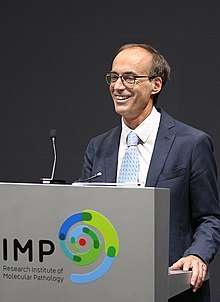Ronald Vale
| Ronald D. Vale | |
|---|---|
 Vale in September 2018 | |
| Born |
January 11, 1959 Hollywood, California |
| Nationality | American |
| Alma mater | University of California, Santa Barbara, Stanford University, Marine Biological Laboratory |
| Known for | Molecular motors, kinesin, dynein |
| Awards |
|
| Scientific career | |
| Fields | Biochemistry, Cell Biology |
| Institutions | University of California, San Francisco, Howard Hughes Medical Institute |
| Doctoral advisor | Eric Shooter |
Ronald David Vale (born in Hollywood, California, United States) is a professor of cellular and molecular pharmacology at the University of California, San Francisco. His research is focused on molecular motors particularly on kinesin and dynein.[1] He has been awarded the Albert Lasker Basic Medical Research Award in 2012 with Michael Sheetz and James Spudich. He is a fellow of the American Academy of Arts and Sciences and a member of the National Academy of Sciences. He has been an investigator with the Howard Hughes Medical Institute since 1995,[2] and in 2012 was the president of the American Society for Cell Biology.
Career
Vale earned his BA in biology and chemistry from University of California, Santa Barbara in 1980. He then entered a MD/PhD program at Stanford University. Vale did his graduate work in the laboratory of Eric Shooter, where he pursued the question of how biomolecules were transported inside of nerve cells.[3] During this time, Vale visited the Marine Biological Laboratory at Woods Hole so he could study this question in the squid giant axon.
It was at MBL in 1985 that he discovered kinesin by observing the movement of organelles moving along microtubule filaments in squid axons similar to what had been seen by Michael Sheetz and James Spudich with myosin. However, when examining this new system, he recognized that the movement was independent of the myosin and actin system.[4] Vale, Sheetz, and Thomas Reese were able to purify kinesin and demonstrate its force-generating properties.[5] After receiving his PhD, Vale returned to the Marine Biological Laboratory to do postdoctoral research.[2]
Vale joined the UCSF faculty in 1986. Using plastic beads, he was able to track the motion of the motors moving along microtubules. To observe the force-generating action of kinesin, the Vale laboratory used an optical trapping microscope.[6] Ultimately, his group worked out the molecular steps that kinesin uses to convert energy into mechanical force. In 1995, Vale and colleagues solved the crystal structure of the kinesin motor domain.[7] Since then, the Vale lab has made significant contributions to the field of cell biology, including discovering the severing protein katanin,[8] characterizing dynein's function and structure,[9][10] and identifying other new proteins that regulate the cytoskeleton.[11]
Outreach
Vale has founded several organizations related to science outreach. He founded and continues to support MicroManager, which is free and open-source microscopy software. Vale founded iBiology, which is a library of free online talks given by leading research scientists. Vale participates in many outreach activities in the scientific community in India, including starting and organizing an annual microscopy course in Bangalore as well as a Young Investigator Meeting, which provides a networking opportunity for young scientists. Lastly, he also developed Microscopy 4 Kids, a website that provides a guide for digital microscopy using an inexpensive microscope.
Publications
Awards
- Foreign Fellow of the Indian National Science Academy, 2015[12]
- Massry Prize 2013
- Lasker Award 2012
- Wiley Prize 2012
- Keith R. Porter Lecture 2009
- Member of the American Academy of Arts and Sciences, 2002
- Member of the National Academy of Sciences, 2001
- Biophysical Society Award for Young Investigators 1993
- Shaw Prize 2017, award in Life Science and Medicine with Ian R. Gibbons for their discovery of microtubule-associated motor proteins[13]
References
- ↑ "Vale Lab". Archived from the original on 11 September 2012. Retrieved 24 September 2012.
- 1 2 "Ronald D. Vale, Ph.D." HHMI. HHMI. Retrieved 24 September 2012.
- ↑ Vale, Ron. "Molecular Motor Search". iBioMagazine.org.
- ↑ Vale, RD; Schnapp, BJ; Reese, TS; Sheetz, MP (February 1985). "Movement of organelles along filaments dissociated from the axoplasm of the squid giant axon". Cell. 40 (2): 449–54. doi:10.1016/0092-8674(85)90159-x. PMID 2578324.
- ↑ VALE, R; REESE, T; SHEETZ, M (1 August 1985). "Identification of a novel force-generating protein, kinesin, involved in microtubule-based motility". Cell. 42 (1): 39–50. doi:10.1016/S0092-8674(85)80099-4. PMC 2851632. PMID 3926325.
- ↑ Williams, Sarah (February 12). "Force Factor". HHI. Retrieved 24 September 2012. Check date values in:
|date=(help) - ↑ Hoenger A, Sablin EP, Vale RD, Fletterick RJ, Milligan RA (1995). "Three-dimensional structure of a tubulin-motor-protein complex". Nature. 376 (6537): 271–4. doi:10.1038/376271a0. PMID 7617040.
- ↑ McNally, F. & Vale, R. (1993). "Identification of katanin, an ATPase that severs and disassembles stable microtubules". Cell. 75 (3): 419–29. doi:10.1016/0092-8674(93)90377-3. PMID 8221885.
- ↑ Reck-Peterson SL, Yildiz A, Carter AP, Gennerich A, Zhang N, Vale RD (2006). "Single-molecule analysis of dynein processivity and stepping behavior". Cell. 126 (2): 335–48. doi:10.1016/j.cell.2006.05.046. PMC 2851639. PMID 16873064.
- ↑ Carter AP, Cho C, Jin L, Vale RD (2011). "Crystal structure of the dynein motor domain". Science. 331 (6021): 1159–65. doi:10.1126/science.1202393. PMC 3169322. PMID 21330489.
- ↑ Goshima G, Wollman R, Goodwin SS, Zhang N, Scholey JM, Vale RD, Stuurman N (2007). "Genes required for mitotic spindle assembly in Drosophila S2 cells". Science. 316 (5823): 417–21. doi:10.1126/science.1141314. PMC 2837481. PMID 17412918.
- ↑ "Foreign Fellows Elected 2015 (Effective from January 1, 2016)". Retrieved 23 December 2015.
- ↑ Shaw prize laureate 2017
External links
- Vale Lab Website
- HHMI Bio
- UCSF Bio
- Ron Vale's Talk: "Molecular Motor Search"
- Ron Vale's Seminar: "Molecular Motor Proteins"
- IBIOLOGY HANGOUT WITH DR. RON VALE
- Three iBiology seminars by Ron Vale on YouTube: